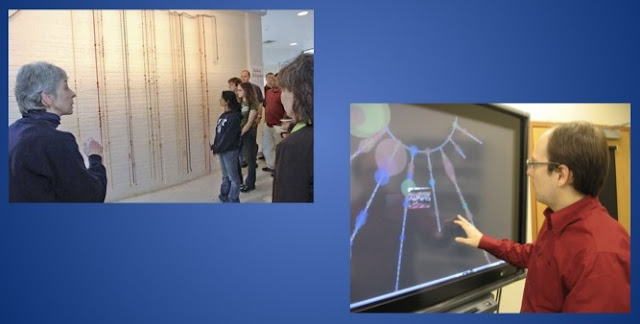Pinning things together....
===
We are all entangled of course.
When I first started playing with html for making websites in the late nineties, it was in the evenings in between knotting embroideries or crochet lace, or later, spinning fiber or knitting. For many of us this web was always textual as in textile, sensory as in fingery, and worldly as in full of worlds maybe only half glimpsed visually yet still palpably immersive across distributed communities, technologies, embodiments, practices, and sensoria.
Thus it is not surprising that many feminist speculative worlds of materialities, aesthetics, design – “new,” critical, “post” – are thoroughly knotted in common interconnections with (including "against") the so-called new aesthetics, even if taken too much for granted. Consciousness of play among worlds dynamically re-enveloped is a bit in sf ecologies including all of these…. Who do we want to share worlds with, why, when, and how? How shareable can knots be? How "material"? How "entangled"?
A range of feminisms today work across materialities.... hope even to work across trans knowledging processes.... materializing.... (Hayward 2010; Haraway 2011; King 2011, 2012; Vered 1998; Bleecker 2008)
===
In Knots.
“The word khipu comes from the Quechua word for “knot" and denotes both singular and plural. Khipu are textile artifacts composed of cords of cotton or occasionally camelid fiber. The cords are arranged such that there is one main cord, called a primary cord, from which many pendant cords hang. There may be additional cords attached to a pendant cord; these are termed subsidiaries. Some khipu have up to 10 or 12 levels of subsidiaries. Khipu are often displayed with the primary cord stretched horizontally, so that the pendants appear to form a curtain of parallel cords, or with the primary cord in a curve, so that the pendants radiate out from their points of attachment. When khipu were in use, they were transported and stored with the primary cord rolled into a spiral. In this configuration khipu have been compared to string mops.” (Urton & Brezine 2003-)
It was in the context of research on historical and cross-cultural writing technologies that I first learned about the khipu, this Andean recording device made from strings and knots, once considered "counting" and not "writing." What counts as writing? as counting? as connecting or disconnecting them? Restructuring knowledge systems in the nineties and after create contexts -- economies, critical design, speculative feminisms, technology infrastructures, excavations, new historical knowledges -- for cascading • forms of attention and • frames of analysis for alternative khipu speculations at different • grains of detail. The khipu is both something to think WITH and something to think ABOUT.
 |
| Fiber & ethnocategories in Lechtman's MIT course for engineers; interactive demo for Bongen & Karahoalios' Photo Khipu |
Khipu knowledges today are created, shared, demonstrated, used, and stored in many writing technological forms: not only monographs, books, conference talks, but also websites, databases, images, exhibitions, reenactments, television documentaries, tourist and heritage tours, sites and festivals, as well as village and kinship ritual work processes. Gender and nationality, ethnicity and race, indigenous politics and university restructuring, all play roles in such systems entangled as current processes of globalization. (King 2010 [2008]; Anderson et al. 2009; Beynon-Davies 2007; 2009; 2012; Lechtman 2010; Bongen & Karahalios 2009; and others linked on my Pinterest site)
Khipu are things in the sense joked about by Bruno Latour: "Facts are no longer the mouth-shuting alternative to politics, but what has to be stabilized instead. To use another etymology, 'objects' which had been conceived as wholly exterior to the social and political realm, have become 'things' again, that is, in the sense of the mixture of assemblies, issues, causes for concerns, data, law suits, contoversies which the words res, causa, chose, aitia, ding have designated in all the European languages."
In some communities of practice, is it fun, a kind of serious play, to consider khipu even as design fictions: and then wonder for whom and how? (Latour 2002:21; Bleecker 2006 [1993])
===
“Khipus in Search of Contexts and Vice Versa” (Salomon 2004:18)
What would writing have to mean to include what we may perhaps know about the khipu so far? What does this something called a khipu have to teach us about thing-ness? And what sorts of temporalities do we need to share with khipus in order to figure them out?
Khipus can be understood as interrogations themselves about assumptions embedded in all of these. As agents of and for knowledge play. Anthropologist Salomon likens them to infographics, but he means by this to suggest that khipus have a sort of agency we usually reserve for only one side of that gap we think we jump across to create a “representation” or to engage in “making.”
Khipu possibilities in speculative play today consider how writing might operate as a system or perhaps several interacting systems, each with alternate layers of semiosis mapped onto or perhaps better, mapping themselves together with other objects and features of the world than words, indeed some never verbalized. Some of the most exciting rethinkings of the khipu today are what we might call workarounds for something we might still want to mean by “writing.” The Andes become then a multi-temporal geopolitical zone for considering “writing without words.” (Salomon 2001; Boone & Mignolo 1994; Brokaw 2010a, 2010b)
===


